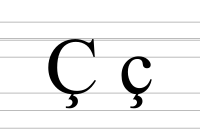C# Excel Datei Öffnen Und Bearbeiten
| Ç | |
|---|---|
| Ç ç | |
| (See below) | |
 | |
| Usage | |
| Writing organisation | Latin script |
| Type | Alphabetic and Logographic |
| Language of origin | Erstwhile Spanish language |
| Phonetic usage | [s] [t͡ʃ] [d͡ʒ] [t͡s] [d͡z] [ç] [ɽ] [ǂ] [θ] [ð] [ɕ] |
| Unicode codepoint | U+00C7, U+00E7 |
| History | |
| Evolution |
|
| Time period | ~900 to present |
| Descendants | None |
| Sisters | None |
| Transliteration equivalents | ch, c, s, ts |
| Variations | (See beneath) |
| Other | |
| Other letters commonly used with | c, ch, s, ts |
Ç or ç (C-cedilla) is a Latin script letter, used in the Albanian, Azerbaijani cluster, Manx, Tatar, Turkish, Turkmen, Kurdish, Zazaki, and Romance alphabets. Romance languages that use this letter include Catalan, French, Friulian, Ligurian, Occitan, and Portuguese every bit a variant of the letter C with a cedilla. It is besides occasionally used in Crimean Tatar and in Tajik (when written in the Latin script) to stand for the /d͡ʒ/ sound. Information technology is oftentimes retained in the spelling of loanwords from any of these languages in English, Basque, Dutch, Spanish and other languages using the Latin alphabet.
Information technology was first used for the sound of the voiceless alveolar affricate /t͡s/ in Old Spanish and stems from the Visigothic form of the letter z (Ꝣ). The phoneme originated in Vulgar Latin from the palatalization of the plosives /t/ and /k/ in some weather condition. Later, /t͡s/ changed into /s/ in many Romance languages and dialects. Spanish has not used the symbol since an orthographic reform in the 18th century (which replaced ç with the now-devoiced z), but it was adopted for writing other languages.
In the International Phonetic Alphabet, /ç/ represents the voiceless palatal fricative.
Usage equally a letter variant in various languages [edit]

Evolution from Visigoth Z to modern Ç.
In many languages, ⟨ç⟩ represents the "soft" sound /southward/ where a ⟨c⟩ would commonly represent the "hard" sound /k/. These include:
- Catalan. Known as ce trencada ('broken C') in this language, where information technology can be used before ⟨a⟩, ⟨o⟩, ⟨u⟩ or at the end of a word. Some examples of words with ⟨ç⟩ are amenaça ('menace'), torçat ('twisted'), xoriço ('chorizo'), forçut ('strong'), dolç ('sweet') and caça ('hunting'). A well-known word with this grapheme is Barça, a common Catalan clipping of Futbol Gild Barcelona.
- French (cé cédille): français ('French'), garçon ('boy'), façade ('frontage'), grinçant ('squeaking'), leçon ('lesson'), reçu ('received' [past participle]). French does not use the character at the end of a word just it tin occur at the offset of a word (eastward.1000., ça, 'that').[i] It is never used in French where C would announce /due south/.
- Occitan (ce cedilha): torçut ('twisted'), çò ('this'), ça que la ('nevertheless'), braç ('arm'), brèç ('cradle'), voraç ('voracious'). It can occur at the first of a discussion.
- Portuguese (cê-cedilha, cê de cedilha or cê cedilhado): it is used before ⟨a⟩, ⟨o⟩, ⟨u⟩: taça ('loving cup'), braço ('arm'), açúcar ('saccharide'). Modern Portuguese does not use the character at the beginning or at the end of a word (the nickname for Conceição is São, not Ção). According to a Portuguese grammar written in 1550, the letter ç had the audio of /dz/ around that time. Some other grammer written around 1700 would say that the letter ç sounds like /south/, which shows a phonetic evolution that is still valid today.
- Old Spanish used ç to represent /t͡s/ before /a/, /o/, /u/. It likewise represented /d͡z/ allophonically when it occurred before a voiced consonant.
- Early Modern Spanish used the letter ç to represent either /θ/ or /s/ before /a/, /o/, and /u/ in much the aforementioned way as Modernistic Spanish uses the letter z. Centre Castilian Spanish pronounced ç equally /θ/, or as /ð/ before a voiced consonant. Andalusian, Canarian, and Latin American Castilian pronounced ç as /s/, or as /z/ before a voiced consonant. A spelling reform in the 18th century eliminated ç from Spanish orthography.
In other languages, it represents the voiceless postalveolar affricate /t͡ʃ/ (like ⟨ch⟩ in English chalk):
- Friulian (c cun cedilie) before ⟨a⟩, ⟨o⟩, ⟨u⟩ or at the end of a give-and-take.
In Manx, it is used in the digraph ⟨çh⟩, which also represents /t͡ʃ/, to differentiate information technology from normal ⟨ch⟩, which represents /10/.
In loanwords only [edit]
- In Basque, ⟨ç⟩ (known equally ze hautsia) is used in the loanword Curaçao.
- In Dutch, information technology can be found in some words from French and Portuguese, such as façade, reçu, Provençaals and Curaçao.
- In English, ⟨ç⟩ is used in loanwords such as façade and limaçon (although the cedilla mark is often dropped: ⟨facade⟩, ⟨limacon⟩).
Usage as a separate letter of the alphabet in diverse languages [edit]
It represents the voiceless postalveolar affricate /t͡ʃ/ in the following languages:
- the fourth letter of the alphabet of the Albanian alphabet.
- the 4th letter of the Azerbaijani alphabet.
- the 4th letter of the Turkish alphabet.
- the 3rd letter of the Turkmen alphabet.
- the 4th letter of the Kurmanji alphabet (too known as Northern Kurdish).
- the 4th letter of the Zazaki alphabet.
In the 2020 version of the Latin Kazakh Alphabet, the letter of the alphabet represents the voiceless alveolo-palatal affricate /tɕ/, which is similar to /t͡ʃ/.
It previously represented a voiceless palatal click /ǂ/ in Juǀʼhoansi and Naro, though the former has replaced it with ⟨ǂ⟩ and the latter with ⟨tc⟩.
The similarly shaped letter the (Ҫ ҫ) is used in the Cyrillic alphabets of Bashkir and Chavash to represent /θ/ and /ɕ/, respectively.
In Tatar, ç represents /ɕ/.
It also represents the retroflex flap /ɽ/ in the Rohingya Latin alphabet.
Janalif uses this alphabetic character to stand for the voiced postalveolar affricate /d͡ʒ/
One-time Malay uses ç to represent /dʒ/ and /ɲ/.
Computer [edit]
| Preview | Ç | ç | Ꝣ | ꝣ | ||||
|---|---|---|---|---|---|---|---|---|
| Unicode name | LATIN Upper-case letter C WITH CEDILLA | LATIN Minor Letter C WITH CEDILLA | LATIN Capital LETTER VISIGOTHIC Z | LATIN Small-scale LETTER VISIGOTHIC Z | ||||
| Encodings | decimal | hex | dec | hex | dec | hex | december | hex |
| Unicode | 199 | U+00C7 | 231 | U+00E7 | 42850 | U+A762 | 42851 | U+A763 |
| UTF-8 | 195 135 | C3 87 | 195 167 | C3 A7 | 234 157 162 | EA 9D A2 | 234 157 163 | EA 9D A3 |
| Numeric character reference | Ç | Ç | ç | ç | Ꝣ | Ꝣ | ꝣ | ꝣ |
| Named character reference | Ç | ç | ||||||
Input [edit]
On Albanian, Belgian, French, Portuguese, Spanish, Turkish and Italian keyboards, Ç is directly available as a carve up primal; however, on most other keyboards, including the Us and British keyboard, a combination of keys must be used:
- In the Us-International keyboard layout, these are ' followed by either C or ⇧ Shift+C. Alternatively one may press AltGr+, or AltGr+⇧ Shift+,.
- In classic Mac Os and macOS, these are ⌥ Opt+C and ⌥ Opt+⇧ Shift+C for lower- and uppercase, respectively.
- In the X Window Organization and many Unix consoles, 1 presses sequentially Etch, , and either C or ⇧ Shift+C. Alternatively, one may printing AltGr+= and then either C or ⇧ Shift+C.
- In Microsoft Windows, these are Alt+0 2 3 1 or Alt+1 iii five for lowercase and Alt+0 1 nine 9 or Alt+1 2 eight for uppercase.
- In Microsoft Word, these are Ctrl+, then either C or ⇧ Shift+C.
- The HTML graphic symbol entity references are
çandÇfor lower- and uppercase, respectively. - In TeX and LaTeX,
\cis used for adding the cedilla accent to a letter, and so\c{c}produces "ç".
See likewise [edit]
- Ҹ
References [edit]
- ^ The Académie Française online dictionary besides gives çà and çûdra.
![]()
Look up Ç or ç in Wiktionary, the free dictionary.
C# Excel Datei Öffnen Und Bearbeiten,
Source: https://en.wikipedia.org/wiki/%C3%87
Posted by: fickmucend.blogspot.com


0 Response to "C# Excel Datei Öffnen Und Bearbeiten"
Post a Comment